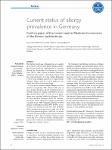Current status of allergy prevalence in Germany
Bergmann, Karl-Christian
Heinrich, Joachim
Niemann, Hildegard
The lifetime prevalence of allergic diseases in adults in Germany [self-reported doctor diagnosed allergic diseases, Study on Adult Health in Germany (Studie zur Gesundheit Erwachsener in Deutschland, DEGS1, 2008–2011) of the Robert Koch Institute] is 8.6 % for asthma, 14.8 % for hay fever, 3.5 % for atopic dermatitis, 8.1 % for contact dermatitis, 4.7 % for food allergies, and 2.8 % for insect venom allergies. Almost 20 % of German adults are currently affected by at least one allergy. In tests on 50 common single allergens and two mixtures comprising either inhalant allergens or grass pollen allergens, 48.6 % of participants exhibited at least one allergic sensitization (specific IgE antibody detection). Overall, 33.6 % of participants were sensitized to inhalant allergens, 25.5 % to at least one food allergens, and 22.6 % to at least one insect venom allergens. A comparison of data on adults from 1998 [Federal Health Survey 1998 (Bundes-Gesundheitssurvey 1998, BGS98) of the Robert Koch Institute] and 2008–2011 (DEGS1) shows an increase in prevalence over time of almost three percentage points, while the rate of sensitization to inhalant allergens has increased from 29.8 % to 33.6 %. The prevalence of doctor diagnosed hay fever, atopic dermatitis, and food allergies, on the other hand, has remained virtually unchanged over the last 15 years. The Germany-wide lifetime prevalence of allergic diseases in children and adolescents [Study on the Health of Children and Adolescents in Germany (Studie zur Gesundheit von Kindern und Jugendlichen in Deutschland, KiGGS initial survey, 2003–2006) of the Robert Koch Institute] was 4.7 % for asthma, 10.7 % for hay fever, and 13.2 % for atopic dermatitis. Altogether, 40.8 % of German children and adolescents were sensitized to at least one of the inhalant or food allergens measured, while 20.0 % were sensitized to at least one food allergen. A marked increase in hay fever prevalence among East German children in the 1990s has resulted in an alignment of prevalence rates in East and West Germany. In contrast to adults, there was no longer a discernible difference in the prevalence of asthma, hay fever, and allergic sensitization in children between the western and eastern German federal states. In international comparisons with prevalence data from other studies, the participating German centers are in the lower third of the distribution of frequency for both children and adults.
No license information

